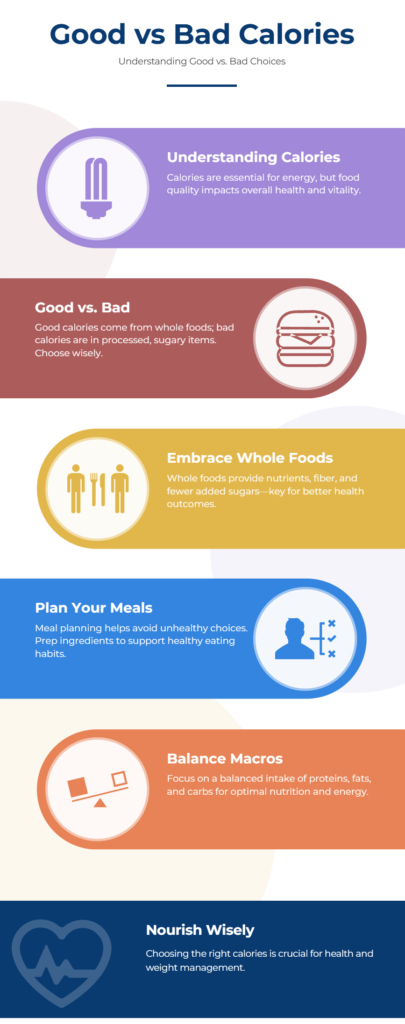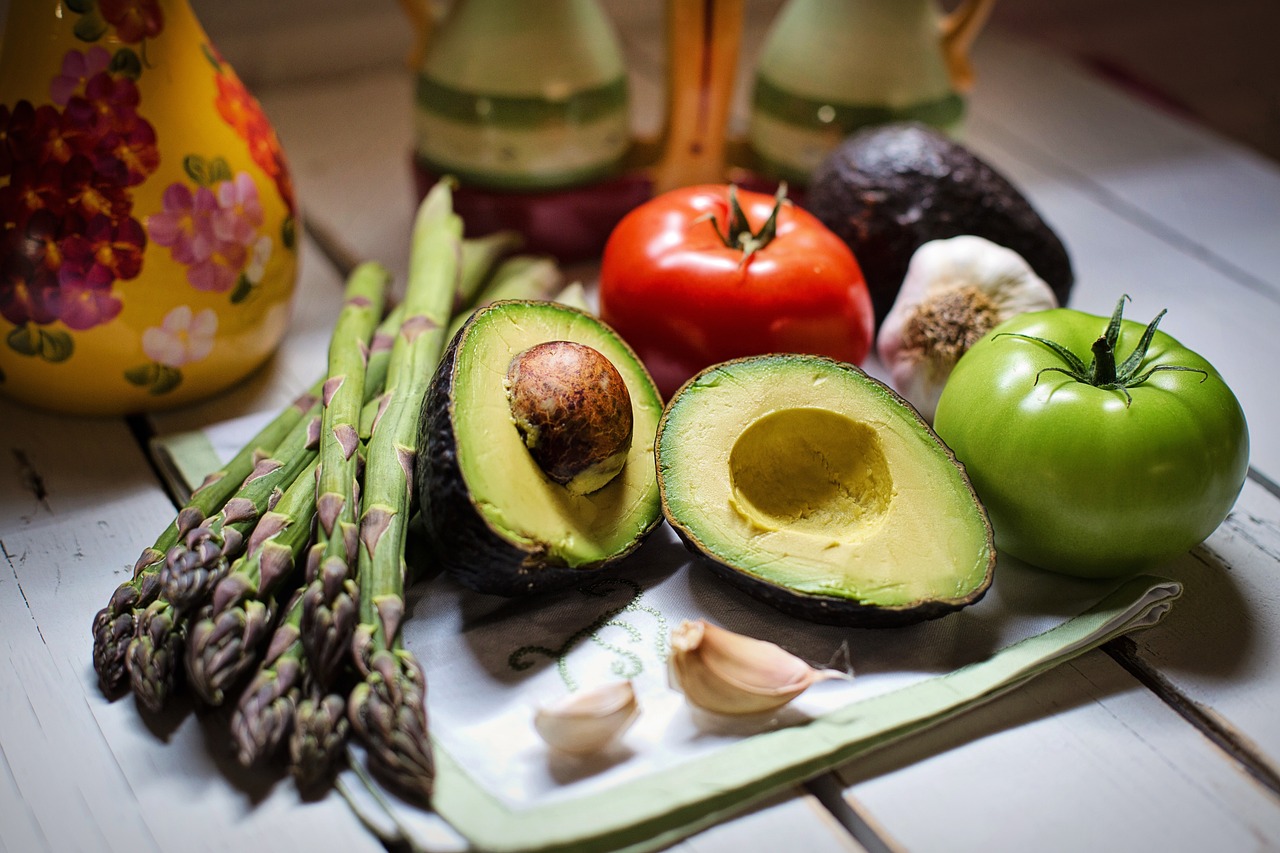Don’t miss a post. Click here to sign up for our free newsletter.
Estimated reading time: 6 minutes
Good Calories vs Bad Calories
When it comes to weight management, the age-old adage holds true: calories eaten versus calories burned determines whether the number on the scale goes up, down, or stays the same. But here’s the kicker: not all calories are created equal. A calorie from a sugar-laden soda doesn’t have the same impact on your body as a calorie from a nutrient-packed avocado.
In this post, we’ll explore the nuances of “good” and “bad” calories, dive into the benefits of whole foods, and discuss practical strategies to make healthier food choices. Let’s take your nutrition to the next level!
The Basics of Calories: Why Quality Matters
At its core, a calorie is a unit of energy. When you consume food, your body uses those calories to fuel everything from your heartbeat to your workouts. But beyond just providing energy, food plays a vital role in overall health. The quality of the calories you consume can influence your energy levels, mood, immune function, and even long-term health outcomes.
Good Calories vs. Bad Calories
- Good Calories: These come from nutrient-dense foods that provide vitamins, minerals, fiber, and healthy fats. Think fruits, vegetables, lean proteins, whole grains, and nuts.
- Bad Calories: These are often found in processed foods high in added sugars, unhealthy fats, and empty carbohydrates. Examples include sugary beverages, chips, candy, and pastries.
While a calorie deficit is essential for weight loss, consistently choosing nutrient-dense foods ensures you’re nourishing your body while shedding pounds. The goal is to achieve a negative calorie balance without sacrificing health and vitality.
Whole Foods: The Gold Standard of Nutrition
One of the simplest yet most impactful dietary changes you can make is to prioritize whole foods. These are minimally processed and closer to their natural state, making them rich in nutrients and free of unnecessary additives.
Why Whole Foods Are King
- Nutrient Density: Whole foods are packed with vitamins, minerals, and antioxidants that processed foods lack.
- Fiber Content: Whole foods, especially fruits, vegetables, and whole grains, are rich in fiber. Fiber helps with digestion, keeps you full longer, and supports a healthy gut microbiome.
- Reduced Sugar: Whole foods naturally contain less added sugar, which can help regulate blood sugar levels and reduce inflammation.
Home-Cooked Meals: A Game Changer
Preparing meals at home gives you complete control over ingredients, portion sizes, and cooking methods. Studies show that people who cook more meals at home tend to consume fewer calories and eat a more nutritious diet.
Start by:
- Experimenting with simple, wholesome recipes.
- Batch cooking to save time during the week.
- Incorporating seasonal fruits and vegetables to add variety and nutrients.
The Role of Macros: Getting the Right Balance
Pay attention to your macronutrients—protein, carbohydrates, and fats to optimize your diet. Each plays a unique role in supporting your body’s functions.
Protein: The Building Block
- Importance: Essential for muscle repair, immune function, and satiety.
- Sources: Lean meats, fish, eggs, tofu, legumes, and Greek yogurt.
- Tip: Aim for about 20-30 grams of protein per meal to promote fullness and support muscle maintenance.
Healthy Fats: Not the Enemy
- Importance: Supports brain health, hormone production, and energy storage.
- Sources: Avocados, nuts, seeds, olive oil, and fatty fish like salmon.
- Tip: Choose unsaturated fats over trans fats and avoid fried foods when possible.
Carbohydrates: Quality Over Quantity
- Importance: The body’s primary energy source.
- Sources: Whole grains, fruits, vegetables, and legumes.
- Tip: Opt for complex carbs that release energy slowly, like quinoa or sweet potatoes, instead of refined carbs like white bread or sugary snacks.
Fiber: The Unsung Hero
- Importance: Helps with digestion, stabilizes blood sugar, and supports heart health.
- Sources: Vegetables, fruits, whole grains, legumes, and nuts.
- Tip: Adults should aim for at least 25-30 grams of fiber per day.
Processed Foods and Sugared Drinks: The Pitfalls
While occasional indulgence is fine, making processed foods and sugary drinks a staple in your diet can lead to weight gain, energy crashes, and long-term health risks.
Why Limit Processed Foods?
- High in empty calories.
- Loaded with added sugars, unhealthy fats, and sodium.
- Low in nutrients, making them less satiating.
The Problem with Sugary Beverages
Drinks like soda, sweetened coffee, and fruit juices are often calorie-dense but nutrient-poor. Research shows that liquid calories are less filling than solid food, leading to overconsumption.
Pro Tip: Choose water, herbal tea, or sparkling water with a splash of lime instead. If you’re craving something sweet, try infusing water with fresh fruits like berries or citrus.
The Power of Planning Ahead
When hunger strikes and you’re unprepared, reaching for the nearest convenience food is easy. Combat this by planning and prepping meals in advance.
Meal Planning Tips
- Start Small: Plan just a few meals and snacks for the week.
- Batch Cook: Make larger portions of soups, stews, or roasted vegetables to have leftovers.
- Snack Smart: Prep healthy snacks like sliced veggies, hard-boiled eggs, or trail mix to curb cravings.
The Science of Willpower
Making decisions about food when you’re tired or hungry can lead to poor choices. Research suggests that willpower is a finite resource, meaning it’s easier to stick to healthy habits when you plan ahead.
- Plan when you’re energized: Create a meal plan or grocery list after a good night’s sleep or a productive morning.
- Keep healthy options visible: Stock your fridge and pantry with nutritious, ready-to-eat foods.
In Summary: Balance Is Key
Achieving a healthy weight isn’t just about eating fewer calories; it’s about choosing the right calories. By prioritizing whole foods, balancing macronutrients, and planning ahead, you can nourish your body and support your goals without feeling deprived.
Remember:
- Focus on nutrient-dense, whole foods.
- Limit processed foods and sugary drinks.
- Balance your macros and get enough fiber, protein, and healthy fats.
- Plan meals and snacks in advance to avoid unhealthy choices.
What are your thoughts on the concept of good versus bad calories? Have you noticed a difference in how you feel when you prioritize whole foods? Let’s discuss in the comments below. And if you have tips or recipes to share, we’d love to hear them!
👉 Start today!
Check out The Seven Pillars of Sustainable Health and Wellness, an introduction to our overall wellness coaching strategy.
Subscribe to our free newsletter to receive more health tips right in your inbox, or schedule a free 30-minute 1:1 call for a personal consultation.
Good Calories vs Bad Calories | Cheat Sheet

